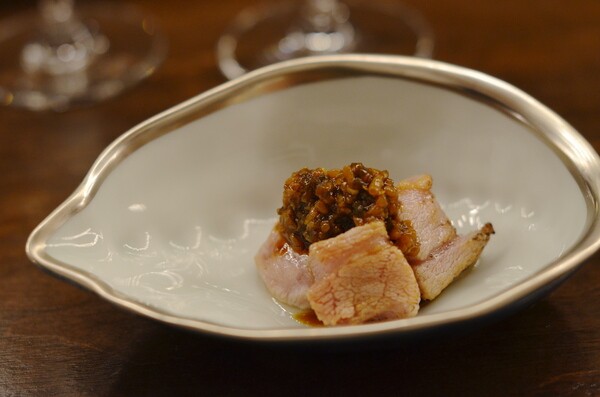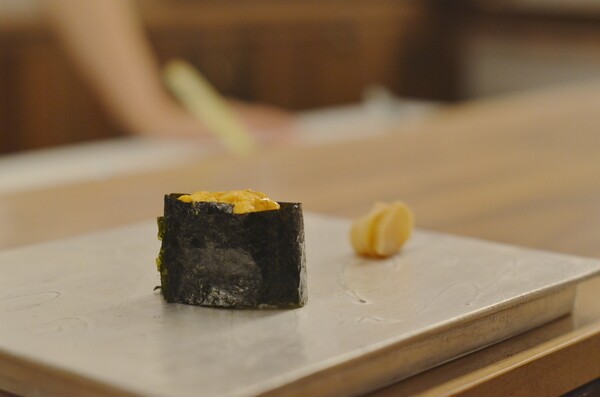Edomae-Style Sushi: A History

Q in downtown Los Angeles is the city's newest sushi bar. It's an omakase-only joint-- which means you pay the fee and for the rest of the dinner, you trust the chef that he'll be serving you only the best.
The food starts at $165 per person, so it won't become a regular part of anyone's restaurant rotation. But, while there are plenty of other high-end, exorbitantly priced sushi bars, (Urasawa in Beverly Hills, for example, cinches the title for the second most expensive restaurant in the United States) Q distinguishes itself for being one of the few places out there serving Edomae-style sushi. It's a style that originates from the Edo period, where simplicity was paramount.
A history lesson:
What we commonly know as raw fish over rice is actually fairly recent even to the Japanese culture. Sushi, which means sour in Japanese, was initially a way to preserve and ferment fish. No raw fish was involved. The protein would be stuffed with salt, stored, weighed down by a stone and left to dry for six months. It started out in Southeast Asia along the Mekong River, spread up China to Yunnan, and then made its way up to Japan.
Rice was then added in the process, but the makers would discard it after the fermentation period was over. Soon vinegar was introduced into the mix, and it wasn't until the Edo period in the 18th century that what we now know as sushi -- raw fish over rice -- was invented.
It was initially a fast food item, meant to be eaten quickly, as refrigeration wasn't readily available back then. According to Yoko Isassi, a Japanese food historian and cooking class teacher in Los Angeles, it was primarily because of the constant building fires in the Edo period. "Because of the fires, there was always construction," she said. "To feed those construction workers, there were many food stalls on the street. Soba, tempura, and sushi, or what we call Edomae-sushi, were the popular selections on the street."
As time progressed and as refrigeration became more prolific, so did the sushi. Today, colorful rolls dotted with various hues of mayonnaise and hot sauces grace our sushi counters.

There are few traditionalists, even in Japan. Chef Hiroyuki Naruke, who owned a six-seat Tokyo restaurant, was one of few -- known for his Edomae-style preparation methods. "Although Edomae nowadays can mean just a slice of raw fish with rice, Edomae-style sushi chefs have more pride to serve the best of the best," Isassi said.
Naruke was discovered by sushi enthusiasts from the law firm Quinn Emanuel Urquhart & Sullivan. They fished him (pun intended) out of Tokyo to Los Angeles following the 2011 tsunami and fears of contaminated fish. As of December, he's now here in downtown Los Angeles at an intimate 26-seat space restaurant. Q, named after Quinn, is all about preserving the purity of Edomae-style sushi.

For example, Naruke is adamant on using red vinegar for his rice. "Red vinegar was the more common vinegar back then," Isassi explained, "It's tinted just a little bit so it won't color the rice much.
He adds a pinch of salt and unlike other joints, forgoes the use of sugar, "Edomae-style doesn't use much sugar at all," Isassi said. "It's all about balance of rice, vinegar and salt. Some chefs claim that rice was naturally sweeter in old days and therefore there was no need to use sugar."
There are also certain fish preparation techniques unique to Edomae sushi chefs.
"They used seasonal fish that was caught in the Tokyo Bay area," she said. "Eel is cut from the back as opposed to belly side which was common in Kansai, Kyoto, and Osaka area. Tokyo, or Edo, was a samurai society and cutting the belly was a taboo. There are popular clams in Edomae, but those are prohibited from being exported to the States. Some curing or cooking was actually done to most of the fishes as there were no refrigerator back then."
Q imports its fish from around the world, though their uni comes from San Diego, and abalone is sourced from Santa Barbara. During one sitting, we had three dishes from Spain, red snapper from New Zealand, and geoduck and aoyagi (a yellow round clam) from Boston. A typically meal runs 20 courses long. Wasabi isn't just handed to you; it's carefully glazed on top. Some bites come brushed with a hint of miso and others, a delicate soy sauce. You're expected to eat the pieces in one bite. The entire process is remarkably simplistic and if you pay close attention -- invaluably educational.
521 W 7th Street, Los Angeles, CA, 90014.






